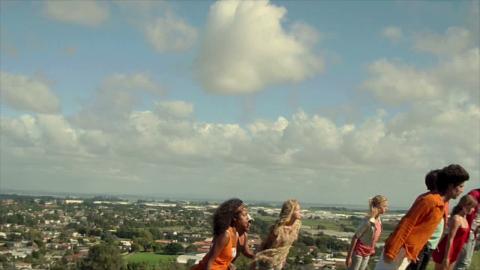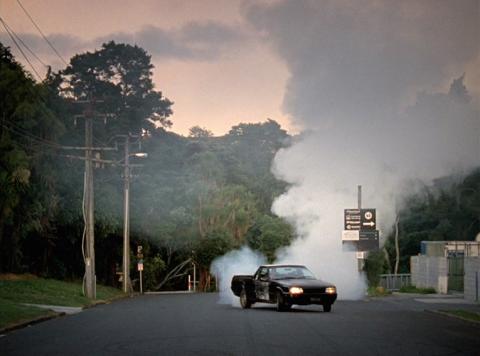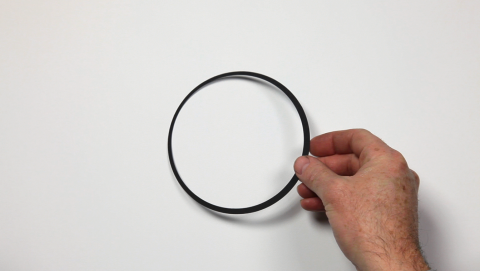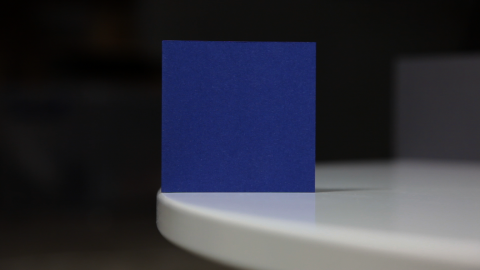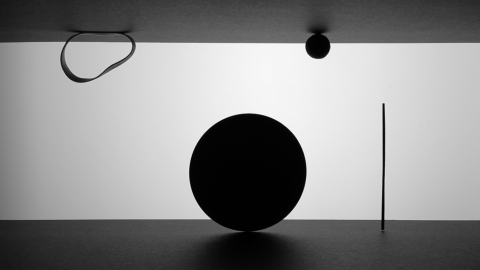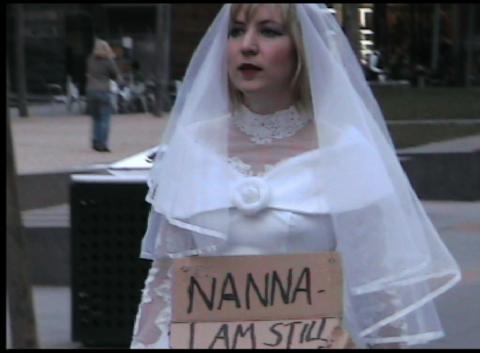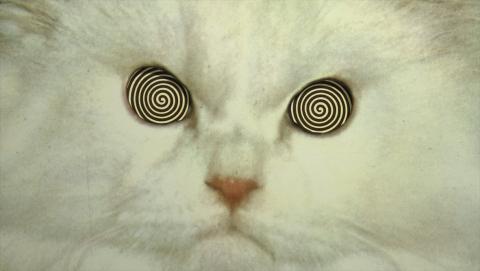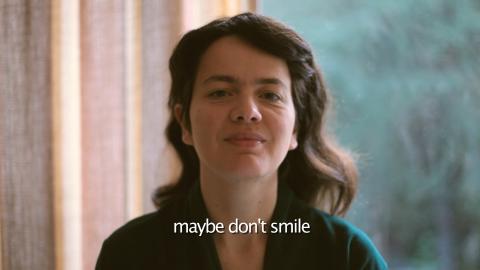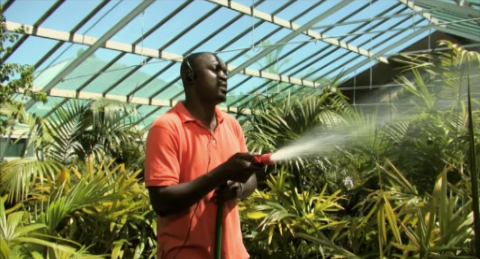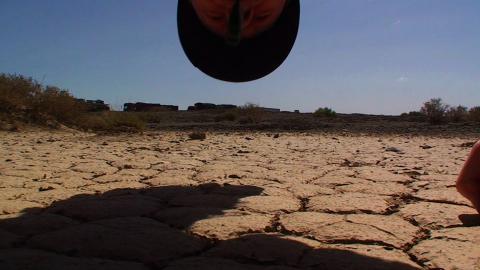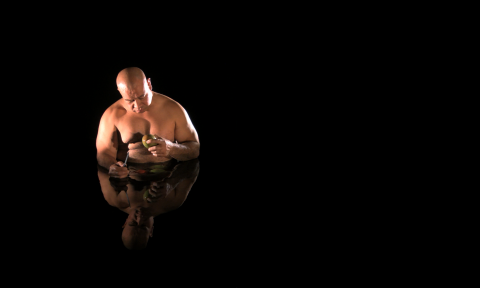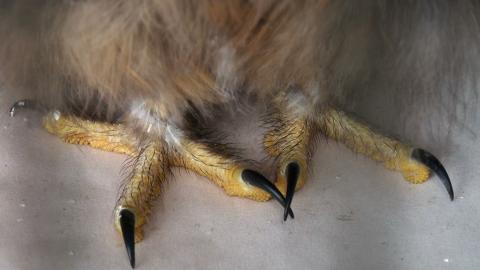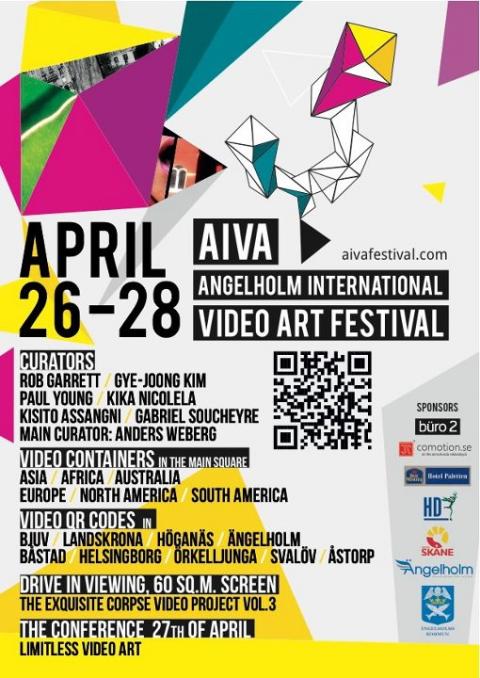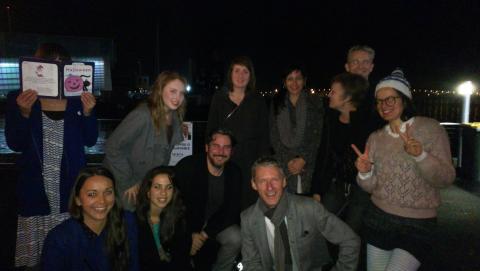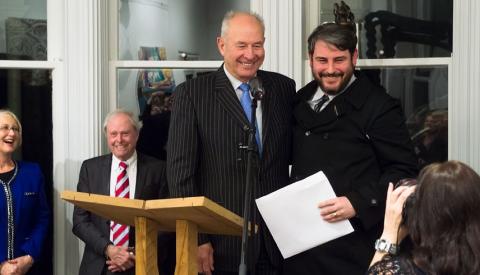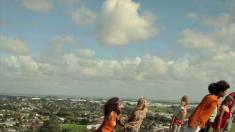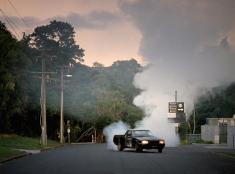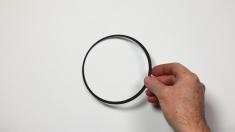Don’t hold your breath
Ängelholm International Video Art Festival
The opening video in the New Zealand-Australia programme encapsulates beautifully the paradox of viewing many video artworks. On the one hand, the ubiquity of the video form creates an impression of immediacy; and the impression that we are witness to something. Yet on the other hand, many artists delight in creating a veil of mystery, obfuscation or contradiction, which undermines the sure ground of the witness experience.
In Andrew de Freitas’ work It’s three in the afternoon, we know we are looking at a group of people swaying in unison, located in some high place with a sprawling park-like city behind them. But what are they actually doing; and why are they doing it? This is not explained. We witness their loosely synchronised movements; they seem oblivious to the camera; and nothing more happens or is shown to give us context, cause or resolution. In a way, nothing happens.
It is this refusal to create a narrative arch that unites many of the ten artists selected for the New Zealand-Australia programme. Instead, the videos by these artists seem to try to hold us within a particular moment; within the nuances of an immediate, rather than future, experience. Don’t hold your breath is a common colloquialism in English that means “nothing else will happen; don’t hold out hope!” Don’t hold your breath could be the motto for the selected video artworks. But the artists are not trying to annoy or frustrate; in fact, each gives us something beautiful, fascinating, thoughtful or meditative in the moment that they unfold before us.
The very last video in this programme, Owl Breathing by Denise Batchelor, is a close-up of the lower abdomen and feet of a standing owl. I have watched this work many times, and always I find my body responding to what I am seeing. After a short while I notice that my breathing begins to synchronise with the owl’s inhaling and exhaling of breath which is simply indicated by the rhythmic movement of its feathers. It becomes a mesmerising, calming, meditative few moments. Perhaps not everyone will experience this; but its gentle ability to get under my skin is why I think this artist’s work is interesting.
Daniel von Sturmer’s sequence of short videos from his series The Cinema Complex defies our perceptions of what is “up” and “down.” Watching these simple “games” with everyday studio objects, the viewer who realises the gravity defying objects are not a product of digital animation or computer manipulation, will become aware that they are seeing things upside-down or sideways, in contradiction of our usual expectations that the camera has its feet on terra firma just as we normally do. Like Batchelor’s Owl Breathing, von Sturmer’s playful small works have the potential to turn us into witnesses of our own senses.
Jill Kennedy tantalises us with play of another kind. One Minute Enlightenment creates a fanciful, and one suspects, ironically critical, impression of homespun collage and stop-frame animation. The retro black and white hypnosis spirals that she has inserted in place of the cats’ eyes are a light-hearted reference to the ways we can mesmerise ourselves with our hobbies and obsessions; and they hark back to Marshall McLuhan’s critique of the media’s power to enthral us. Coming from a coastal city, these spirals also remind me of tiny molluscs found in Auckland’s inter-tidal zone. I remember as a child spending hours crouched over rock pools, the sun backing my back, fascinated by every discovery, and among them the snail-shaped molluscs, called “Cat’s Eyes” which have spiral patterned pearlescent covers at their opening to protect the moist creature inside during the dry low-tide. Thus, One Minute Enlightenment suggests to me the idle yet productive timelessness of children’s unstructured play.
In Burn Out Steve Carr turns the noisy, smelly and high-energy suburban pursuit of “boy racers” into a lyrical and romantic image. Carr’s subject is one of the favourite late-night hobbies of young men with powerful modified cars, and the bane of many suburban residents. The “burn out” is a game where crowds of men in their cars and onlookers gather to take turns spinning their car’s rear wheels on a diesel slicked road by revving the engine in low gear while holding the hand break on. The manic tires burn the diesel and create a cloud of pungent white-blue smoke as the car roars, drifts and slides in slow and erratic circles. Yet in Carr’s video we see a lone car, viewed from a long way off at the end of a leafy street: no crowds of onlookers, in broad daylight, no noise (and of course no smell). Here the burn out becomes as poetic and beautiful as a Chinese watercolour painting.
In Self Titled by Karin Hofko we witness the artist sit before the camera and proclaim passionate and true love. Over and over she finds words and phrases to describe, in fact insist on, her ardour. Who or what is she in love with? We cannot tell; we are not told. But gradually it transpires that something else is going on. Increasingly her image seems self-conscious and perhaps inauthentic; calling to question the truth of what we see; or of what believe we are seeing; and therefore calling to question the reliability of our perceptions, especially our first impressions. I will not say more, for you must see this for yourself to understand. Particularly because what you understand is likely to be quite different from me, your friend, your neighbour, or another. Just as von Sturmer makes us realise what looks up may be down; Hofko’s video calls into question the relationship between the spontaneous and the rehearsed. Who among us has not rehearsed the most potent and poignant feelings, with friends, in front of a mirror, or in our heads, before declaring them?
I am fascinated by artworks that make me cringe. Film for my Nanna by Anastasia Klose is one such as the artist dons a used wedding gown and walks the streets of central Melbourne with a rough hand-made sign about her neck proclaiming “Nanna, I am still alone!” Oh dear, this is so intimate and perhaps melancholy. Or is it? If this sign is in answer to her Nanna’s oft-asked question, then Klose does not seem to share her grandmother’s anxiety about being alone (single, unwed). Surely we are encouraged to laugh along with the artist at the sweet absurdity of parading this condition; made perhaps more humorous by knowing it is her mother who holds the camera, following her daughter through the streets. Even the artist was startled by what transpired.
Rebecca Ann Hobbs knowingly plays with notions of the “Noble Savage” in her lyrical work Ah-round in which the camera slowly circles a dark-skinned man watering tropical plants. New Zealand and Australian artists have a particular relationship to such notions with their nations being founded in the last phase of European colonialism, during the 19th Century; and now working through the concrete dilemmas of post-colonialism in the form of indigenous rights issues. As Hobbs’ video suggests, the field is multi-layered and complex; a dance of the real, imagined, feared, original, copied and regenerated. Ah-round does not attempt to trivialise these matters with its romantic beauty; but instead creates an image onto which our own projections of the “Noble Savage” (servant, master, dancer, lover, or hunter) can be played out and immediately undone as suspect and silly.
The stillness of “nothing much is happening” returns in Rachael Rakena’s Kaore te aroha… (Endless is the love…) in which a large Polynesian man is seated in an inky black space, lovingly, slowly unctuously picking apart and devouring a plate of fish heads. For Maori (New Zealand’s indigenous peoples) this total blackness is powerfully suggestive of primordial beginnings and the world of the demi-gods. On the one hand, Te Po, the Great Night, is the infinite period of the gods prior to the manifestation of light and human life; and on the other hand, it is the inky depths of the ocean where Tangaroa, God of the Sea and provider of seafood (kai moana), has his seat, just as Rakena’s be-calmed figure sits at his black watery table. While there is a loving and meditative depth to this work that seems to make it simultaneously prayer and copulation, there is also something Saturnian and brooding. I am particularly reminded of Francisco Goya’s large dark painting Saturno devorando a su hijo (Saturn Devouring his Son), 1819-23, which the artist kept for himself and had hanging above his own dining table.
Phil Dadson is one of our most senior artists who was a leading figure in New Zealand’s conceptual art movement from the 1970s and is still a vigorous and imaginative practitioner across sound, moving image and sculptural modes. HEADSTAMPS 11 (homage to a silk route) invites us to contemplate the physicality of our own body’s movements and functions (walking, standing, inverting, concentrating, straining and breathing) and to think about how our bodies traverse the physical and aerial spaces of our world; for centuries tamping paths of trade and exchange across the globe. In addition I have selected HEADSTAMPS 11 (homage to a silk route) for AIVA because of its humorous implication that what is up for New Zealanders is down for the Swedish, and vice versa; and because, like Batchelor’s Owl, you cannot watch this video without feeling the presence of your own lungs in your body.
Perhaps there is something relaxed about the New Zealand and Australian lifestyles that gives us this freedom to play, dream and be enthralled; to not hold our breath for something else, but to delight in what is before us, right now. Perhaps it is a more personal filter through which I have viewed and found interesting, the video art of some of our artists. Either way, we invite you too, to stand on your head and travel to the places of sensation and imagination that these videos offer you. Stop for a moment. Remember the timelessness of childhood.
AIVA: Ängelholm International Video Art Festival, Ängelholm, Sweden
Dates: 26-28 April 2012
Lead curator: Anders Weberg
New Zealand-Australia Program curator: Rob Garrett
NZ-Australian artists selected for AIVA:
Andrew de Freitas
Steve Carr
Daniel von Sturmer
Anastasia Klose
Jill Kennedy
Karin Hofko
Rebecca Ann Hobbs
Phil Dadson
Rachael Rakena
Denise Batchelor
LINKS:
